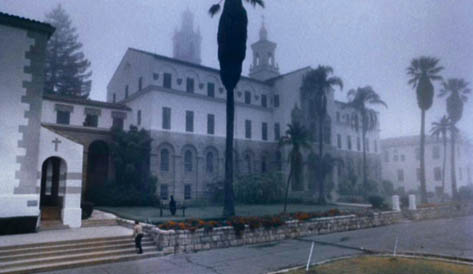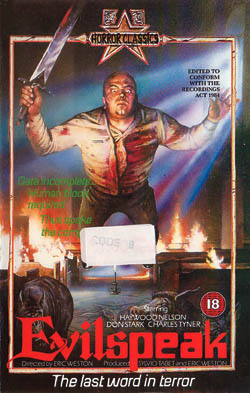The Strange History of St. Anthony’s and the Diabolical Movie Evilspeak
Holy Smoke

Something about the marriage of Catholic iconography-with its stained glass, martyr statues, and arcane Latin inscriptions-to the ultimate Big Bad has long appealed to filmmakers and filmgoers alike. That sentence alone should bring to mind some vivid memories of pop culture devilry from the likes of Rosemary’s Baby, The Omen, or the infamous crucifix scene from The Exorcist, but the connection goes back at least to movies like 1934’s The Black Cat, which pits Bela Lugosi against Boris Karloff amid satanic-themed mayhem.
It stands to reason, then, that a city as rich in Catholic history as Santa Barbara would have popped up in some point in the horror genre, albeit in a way even film diehards may have forgotten. In 1982, the Coronet Film Corporation released Evilspeak, a dark, schlocky chiller starring Clint Howard-Ron’s brother, perhaps best remembered for his childhood role on the TV series Gentle Ben-as Stanley Coopersmith, a social misfit at the prestigious West Andover Military Academy. The subject of endless teasing by classmates and faculty, Stanley eventually stumbles onto a diary kept by Father Esteban, a former Spanish missionary priest who became a devotee of Satan. Stanley scans the book into his computer and ends up willfully summoning the power of the devil to wreak fiery and pointy havoc on his foes, la the finale of Carrie.
Despite its inclusion on Britain’s “Video Nasty” list of inappropriate viewing material in 1984 and its current availability on DVD, Evilspeak seems all but forgotten. It may, however, be of special interest to Santa Barbara residents by virtue of it being filmed almost entirely at St. Anthony’s Seminary. Crews swept in one summer while St. Anthony’s Seminary was out of session and quickly shot a film so shockingly anti-Christian that Anton LaVey, founder of the Church of Satan, purportedly loved it and regarded it as an accurate depiction of his faith. Evilspeak hit theaters shortly after, but to little acclaim. Yet it raises an interesting question: How exactly does a film that would seem to glorify all things non-Christian ever get permission to film in an institution of the Lord?

According to St. Anthony’s staffers, the film got the go-ahead after higher-ups approved a preliminary shooting script described as decidedly PG. Though Fr. Mel Jurisich oversaw goings-on at St. Anthony’s for years, his sabbatical in 1980 left Fr. Alberic Smith in charge. “We didn’t really understand the nature of the film until after it came out,” Smith said of Evilspeak. “It had lots of promise and the script looked okay, and several of us read that. But they kept adding on.”
The content added in after that first script approval, one must conclude, would have probably included the graphic death sequences. The foremost of these is a particularly distasteful scene in which one of the film’s few female characters strips and steps into the shower, where she is messily devoured by pigs. That, coupled with the blood sacrifice of the world’s cutest puppy and the ending sequence-in which a levitating Stanley impales, decapitates, and burns his tormentors in the school chapel, ultimately sending a large cross altarpiece toppling to the ground-make for good reason why Evilspeak did not make the U.S. Conference of Catholic Bishops’ top 10 films of 1982.
Perhaps most offensive to Christian sensibilities is the notion of the protagonist-whom Howard plays as the kind of undeservedly wronged loner ubiquitous to most high schools, real or fictional-turning to Satanism. Unlike the title character in Carrie, Stanley seems to have no remorse for wiping out his classmates, teachers, and even the chaplain. The film’s final shot depicts his face, turned demonic with Tron
Both Smith and Jurisich said they were happy few people saw the film, in Santa Barbara or otherwise. Smith said he never bothered to actually watch it, though he does remember hearing that it bombed. Jurisich, on the other hand, did. “I went incognito down to a theater in Ventura to see it,” he admitted. He was not impressed, calling the whole incident “embarrassing.” And that would seem to mark the end of Santa Barbara’s association with Evilspeak. (The credits, however, thank a special appearance by the Dos Pueblos High School marching band, so likely some current area residents have memories of the film.)
Though Evilspeak probably doesn’t appear on too many people’s favorite films lists, its quick run through theaters didn’t render it completely inconsequential in terms of pop culture legacy. A 1997 episode of Buffy the Vampire Slayer featured a strikingly similar plot, with an evil tome being scanned into a computer and unleashing demonic forces upon the tech-savvy.
One of the unlucky classmates who suffers Stanley’s wrath-specifically by having his still-beating heart plucked from his chest-is a young Don Stark, who is perhaps best known today for his regular role on That ’70s Show. And Clint Howard somehow managed to parlay starring in movies like Evilspeak into a career. His list of subsequent credits in the schlock horror genre include Night Shift, Leprechaun 2, Carnosaur, and Ice Cream Man, the last of which features Howard in the a title role of a mental patient who processes unpleasant children into frosty treats. Finally, Eric Weston-Evilspeak‘s director, who could not be reached for comment-is currently filming the feature Hyenas, which tells the story of human-hyena hybrids who eat people.
In the end, the film offers a strange bit of Santa Barbara history about how a movie of such satanic gore could ever be permitted to film on a location owned by those who might object to such content. And for those curious to rent the film themselves, know this: The only version available on DVD is the uncensored director’s cut, which means more unholy splatter than you would have seen in the theaters anyway.
4•1•1
Evilspeak can be rented on Netflix.com



